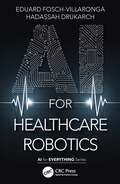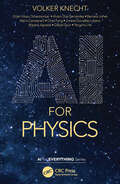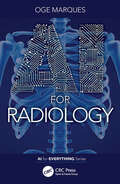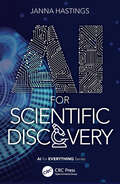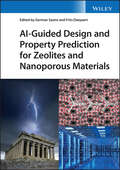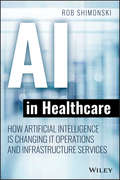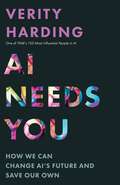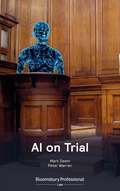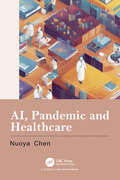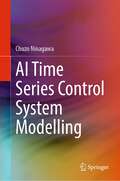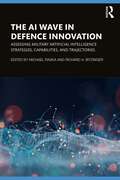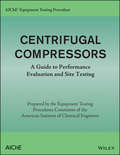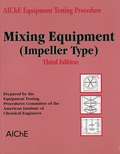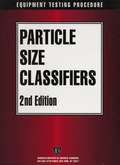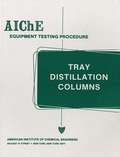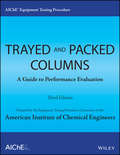- Table View
- List View
AI for Healthcare Robotics (AI for Everything)
by Eduard Fosch-Villaronga Hadassah DrukarchWhat is artificial intelligence (AI)? What is healthcare robotics? How can AI and healthcare robotics assist in contemporary medicine? Robotics and AI can offer society unimaginable benefits, such as enabling wheelchair users to walk again, performing surgery in a highly automated and minimally invasive way, and delivering care more efficiently. AI for Healthcare Robotics explains what healthcare robots are and how AI empowers them in achieving the goals of contemporary medicine.
AI for Healthcare Robotics (AI for Everything)
by Eduard Fosch-Villaronga Hadassah DrukarchWhat is artificial intelligence (AI)? What is healthcare robotics? How can AI and healthcare robotics assist in contemporary medicine? Robotics and AI can offer society unimaginable benefits, such as enabling wheelchair users to walk again, performing surgery in a highly automated and minimally invasive way, and delivering care more efficiently. AI for Healthcare Robotics explains what healthcare robots are and how AI empowers them in achieving the goals of contemporary medicine.
AI for Physics (AI for Everything)
by Volker KnechtWritten in accessible language without mathematical formulas, this short book provides an overview of the wide and varied applications of artificial intelligence (AI) across the spectrum of physical sciences. Focusing in particular on AI's ability to extract patterns from data, known as machine learning (ML), the book includes a chapter on important machine learning algorithms and their respective applications in physics. It then explores the use of ML across a number of important sub-fields in more detail, ranging from particle, molecular and condensed matter physics, to astrophysics, cosmology and the theory of everything. The book covers such applications as the search for new particles and the detection of gravitational waves from the merging of black holes, and concludes by discussing what the future may hold.
AI for Physics (AI for Everything)
by Volker KnechtWritten in accessible language without mathematical formulas, this short book provides an overview of the wide and varied applications of artificial intelligence (AI) across the spectrum of physical sciences. Focusing in particular on AI's ability to extract patterns from data, known as machine learning (ML), the book includes a chapter on important machine learning algorithms and their respective applications in physics. It then explores the use of ML across a number of important sub-fields in more detail, ranging from particle, molecular and condensed matter physics, to astrophysics, cosmology and the theory of everything. The book covers such applications as the search for new particles and the detection of gravitational waves from the merging of black holes, and concludes by discussing what the future may hold.
AI for Radiology (AI for Everything)
by Oge MarquesArtificial intelligence (AI) has revolutionized many areas of medicine and is increasingly being embraced. This book focuses on the integral role of AI in radiology, shedding light on how this technology can enhance patient care and streamline professional workflows. This book reviews, explains, and contextualizes some of the most current, practical, and relevant developments in artificial intelligence and deep learning in radiology and medical image analysis. AI for Radiology presents a balanced viewpoint of the impact of AI in these fields, underscoring that AI technologies are not intended to replace radiologists but rather to augment their capabilities, freeing professionals to focus on more complex cases. This book guides readers from the basic principles of AI to their practical applications in radiology, moving from the role of data in AI to the ethical and regulatory considerations of using AI in radiology and concluding with a selection of resources for further exploration. This book has been crafted with a diverse readership in mind. It is a valuable asset for medical professionals eager to stay up to date with AI developments, computer scientists curious about AI’s clinical applications, and anyone interested in the intersection of healthcare and technology.
AI for Radiology (AI for Everything)
by Oge MarquesArtificial intelligence (AI) has revolutionized many areas of medicine and is increasingly being embraced. This book focuses on the integral role of AI in radiology, shedding light on how this technology can enhance patient care and streamline professional workflows. This book reviews, explains, and contextualizes some of the most current, practical, and relevant developments in artificial intelligence and deep learning in radiology and medical image analysis. AI for Radiology presents a balanced viewpoint of the impact of AI in these fields, underscoring that AI technologies are not intended to replace radiologists but rather to augment their capabilities, freeing professionals to focus on more complex cases. This book guides readers from the basic principles of AI to their practical applications in radiology, moving from the role of data in AI to the ethical and regulatory considerations of using AI in radiology and concluding with a selection of resources for further exploration. This book has been crafted with a diverse readership in mind. It is a valuable asset for medical professionals eager to stay up to date with AI developments, computer scientists curious about AI’s clinical applications, and anyone interested in the intersection of healthcare and technology.
AI for Scientific Discovery (AI for Everything)
by Janna HastingsAI for Scientific Discovery provides an accessible introduction to the wide-ranging applications of artificial intelligence (AI) technologies in scientific research and discovery across the full breadth of scientific disciplines. AI technologies support discovery science in multiple ways. They support literature management and synthesis, allowing the wealth of what has already been discovered and reported on to be integrated and easily accessed. They play a central role in data analysis and interpretation in the context of what is called ‘data science’. AI is also helping to combat the reproducibility crisis in scientific research by underpinning the discovery process with AI-enabled standards and pipelines and supporting the management of large-scale data and knowledge resources so that they can be shared and integrated and serve as a background ‘knowledge ecosystem’ into which new discoveries can be embedded. However, there are limitations to what AI can achieve and its outputs can be biased and confounded and thus should not be blindly trusted. The latest generation of hybrid and ‘human-in-the-loop’ AI technologies have as their objective a balance between human inputs and insights and the power of number-crunching and statistical inference at a massive scale that AI technologies are best at.
AI for Scientific Discovery (AI for Everything)
by Janna HastingsAI for Scientific Discovery provides an accessible introduction to the wide-ranging applications of artificial intelligence (AI) technologies in scientific research and discovery across the full breadth of scientific disciplines. AI technologies support discovery science in multiple ways. They support literature management and synthesis, allowing the wealth of what has already been discovered and reported on to be integrated and easily accessed. They play a central role in data analysis and interpretation in the context of what is called ‘data science’. AI is also helping to combat the reproducibility crisis in scientific research by underpinning the discovery process with AI-enabled standards and pipelines and supporting the management of large-scale data and knowledge resources so that they can be shared and integrated and serve as a background ‘knowledge ecosystem’ into which new discoveries can be embedded. However, there are limitations to what AI can achieve and its outputs can be biased and confounded and thus should not be blindly trusted. The latest generation of hybrid and ‘human-in-the-loop’ AI technologies have as their objective a balance between human inputs and insights and the power of number-crunching and statistical inference at a massive scale that AI technologies are best at.
AI-Guided Design and Property Prediction for Zeolites and Nanoporous Materials
by German Sastre Frits DaeyaertA cohesive and insightful compilation of resources explaining the latest discoveries and methods in the field of nanoporous materials In Artificial Intelligence for Zeolites and Nanoporous Materials: Design, Synthesis and Properties Prediction a team of distinguished researchers delivers a robust compilation of the latest knowledge and most recent developments in computational chemistry, synthetic chemistry, and artificial intelligence as it applies to zeolites, porous molecular materials, covalent organic frameworks and metal-organic frameworks. The book presents a common language that unifies these fields of research and advances the discovery of new nanoporous materials. The editors have included resources that describe strategies to synthesize new nanoporous materials, construct databases of materials, structure directing agents, and synthesis conditions, and explain computational methods to generate new materials. They also offer material that discusses AI and machine learning algorithms, as well as other, similar approaches to the field. Readers will also find a comprehensive approach to artificial intelligence applied to and written in the language of materials chemistry, guiding the reader through the fundamental questions on how far computer algorithms and numerical representations can drive our search of new nanoporous materials for specific applications. Designed for academic researchers and industry professionals with an interest in synthetic nanoporous materials chemistry, Artificial Intelligence for Zeolites and Nanoporous Materials: Design, Synthesis and Properties Prediction will also earn a place in the libraries of professionals working in large energy, chemical, and biochemical companies with responsibilities related to the design of new nanoporous materials.
AI-Guided Design and Property Prediction for Zeolites and Nanoporous Materials
by German Sastre Frits DaeyaertA cohesive and insightful compilation of resources explaining the latest discoveries and methods in the field of nanoporous materials In Artificial Intelligence for Zeolites and Nanoporous Materials: Design, Synthesis and Properties Prediction a team of distinguished researchers delivers a robust compilation of the latest knowledge and most recent developments in computational chemistry, synthetic chemistry, and artificial intelligence as it applies to zeolites, porous molecular materials, covalent organic frameworks and metal-organic frameworks. The book presents a common language that unifies these fields of research and advances the discovery of new nanoporous materials. The editors have included resources that describe strategies to synthesize new nanoporous materials, construct databases of materials, structure directing agents, and synthesis conditions, and explain computational methods to generate new materials. They also offer material that discusses AI and machine learning algorithms, as well as other, similar approaches to the field. Readers will also find a comprehensive approach to artificial intelligence applied to and written in the language of materials chemistry, guiding the reader through the fundamental questions on how far computer algorithms and numerical representations can drive our search of new nanoporous materials for specific applications. Designed for academic researchers and industry professionals with an interest in synthetic nanoporous materials chemistry, Artificial Intelligence for Zeolites and Nanoporous Materials: Design, Synthesis and Properties Prediction will also earn a place in the libraries of professionals working in large energy, chemical, and biochemical companies with responsibilities related to the design of new nanoporous materials.
AI in Healthcare: How Artificial Intelligence Is Changing IT Operations and Infrastructure Services
by Robert ShimonskiThe best source for cutting-edge insights into AI in healthcare operations AI in Healthcare: How Artificial Intelligence Is Changing IT Operations and Infrastructure Services collects, organizes and provides the latest, most up-to-date research on the emerging technology of artificial intelligence as it is applied to healthcare operations. Written by a world-leading technology executive specializing in healthcare IT, this book provides concrete examples and practical advice on how to deploy artificial intelligence solutions in your healthcare environment. AI in Healthcare reveals to readers how they can take advantage of connecting real-time event correlation and response automation to minimize IT disruptions in critical healthcare IT functions. This book provides in-depth coverage of all the most important and central topics in the healthcare applications of artificial intelligence, including: Healthcare IT AI Clinical Operations AI Operational Infrastructure Project Planning Metrics, Reporting, and Service Performance AIOps in Automation AIOps Cloud Operations Future of AI Written in an accessible and straightforward style, this book will be invaluable to IT managers, administrators, and engineers in healthcare settings, as well as anyone with an interest or stake in healthcare technology.
AI in Healthcare: How Artificial Intelligence Is Changing IT Operations and Infrastructure Services
by Robert ShimonskiThe best source for cutting-edge insights into AI in healthcare operations AI in Healthcare: How Artificial Intelligence Is Changing IT Operations and Infrastructure Services collects, organizes and provides the latest, most up-to-date research on the emerging technology of artificial intelligence as it is applied to healthcare operations. Written by a world-leading technology executive specializing in healthcare IT, this book provides concrete examples and practical advice on how to deploy artificial intelligence solutions in your healthcare environment. AI in Healthcare reveals to readers how they can take advantage of connecting real-time event correlation and response automation to minimize IT disruptions in critical healthcare IT functions. This book provides in-depth coverage of all the most important and central topics in the healthcare applications of artificial intelligence, including: Healthcare IT AI Clinical Operations AI Operational Infrastructure Project Planning Metrics, Reporting, and Service Performance AIOps in Automation AIOps Cloud Operations Future of AI Written in an accessible and straightforward style, this book will be invaluable to IT managers, administrators, and engineers in healthcare settings, as well as anyone with an interest or stake in healthcare technology.
AI Needs You: How We Can Change AI's Future and Save Our Own
by Verity HardingA humanist manifesto for the age of AIArtificial intelligence may be the most transformative technology of our time. As AI&’s power grows, so does the need to figure out what—and who—this technology is really for. AI Needs You argues that it is critical for society to take the lead in answering this urgent question and ensuring that AI fulfills its promise.Verity Harding draws inspiring lessons from the histories of three twentieth-century tech revolutions—the space race, in vitro fertilization, and the internet—to empower each of us to join the conversation about AI and its possible futures. Sharing her perspective as a leading insider in technology and politics, she rejects the dominant narrative, which often likens AI&’s advent to that of the atomic bomb. History points the way to an achievable future in which democratically determined values guide AI to be peaceful in its intent; to embrace limitations; to serve purpose, not profit; and to be firmly rooted in societal trust.AI Needs You gives us hope that we, the people, can imbue AI with a deep intentionality that reflects our best values, ideals, and interests, and that serves the public good. AI will permeate our lives in unforeseeable ways, but it is clear that the shape of AI&’s future—and of our own—cannot be left only to those building it. It is up to us to guide this technology away from our worst fears and toward a future that we can trust and believe in.
AI Needs You: How We Can Change AI's Future and Save Our Own
by Verity HardingA humanist manifesto for the age of AIArtificial intelligence may be the most transformative technology of our time. As AI&’s power grows, so does the need to figure out what—and who—this technology is really for. AI Needs You argues that it is critical for society to take the lead in answering this urgent question and ensuring that AI fulfills its promise.Verity Harding draws inspiring lessons from the histories of three twentieth-century tech revolutions—the space race, in vitro fertilization, and the internet—to empower each of us to join the conversation about AI and its possible futures. Sharing her perspective as a leading insider in technology and politics, she rejects the dominant narrative, which often likens AI&’s advent to that of the atomic bomb. History points the way to an achievable future in which democratically determined values guide AI to be peaceful in its intent; to embrace limitations; to serve purpose, not profit; and to be firmly rooted in societal trust.AI Needs You gives us hope that we, the people, can imbue AI with a deep intentionality that reflects our best values, ideals, and interests, and that serves the public good. AI will permeate our lives in unforeseeable ways, but it is clear that the shape of AI&’s future—and of our own—cannot be left only to those building it. It is up to us to guide this technology away from our worst fears and toward a future that we can trust and believe in.
AI on Trial
by Mark Deem Peter WarrenAI on Trial follows the same process as a High Court trial, and in so doing it takes an innovative approach to the most innovative of technological areas.Addressing the current state of artificial intelligence and the law, the book identifies why the technology should be 'placed on trial' and presents relevant evidence, before passing 'judgment' and proposing a Manifesto for Responsible AI and a blueprint for an ethical, legal and regulatory framework.The 'trial' examines such questions as:-Should AI, a computer technology, have rights and responsibilities?-What are the legal and ethical issues created by the implicit bias of coders and data sets?-Is AI racist?-Do we need a Hippocratic Oath in AI?-Could AI lead to a data war to end all wars?-Can we trust AI?Readers will benefit from understanding the necessary considerations in formulating any legal framework and will come to recognise the role of any such framework, not only in preventing harm, but in supporting growth and technological advancement.Written from the viewpoint of practitioners, academics and journalists, this is an essential title for all information and technology law practitioners, in-house counsel, data protection officers, company directors, finance directors, academics and students. Technologists, regulators, legislators and journalists interested in getting to grips with the issues presented by AI will also benefit.
AI, Pandemic and Healthcare
by Nuoya ChenThe demand for telehealth solutions has been growing exponentially after the Covid-19 pandemic. Hospitals remain understaffed, which leads to staff burnouts and unsatisfactory patient experience. They also find it difficult to use AI to reduce the workload for doctors and nurses. Doctors barely use data collected from wearables and home-use medical devices to make diagnosis. As generative AI advances, traditional medical device manufacturers are exploring with open innovation to transform into a software-based business model facing competition from large tech companies and startups. This book shares the perspectives from different stakeholders around the challenges of the use of AI in healthcare.
AI, Pandemic and Healthcare
by Nuoya ChenThe demand for telehealth solutions has been growing exponentially after the Covid-19 pandemic. Hospitals remain understaffed, which leads to staff burnouts and unsatisfactory patient experience. They also find it difficult to use AI to reduce the workload for doctors and nurses. Doctors barely use data collected from wearables and home-use medical devices to make diagnosis. As generative AI advances, traditional medical device manufacturers are exploring with open innovation to transform into a software-based business model facing competition from large tech companies and startups. This book shares the perspectives from different stakeholders around the challenges of the use of AI in healthcare.
AI Time Series Control System Modelling
by Chuzo NinagawaThis book describes the practical application of artificial intelligence (AI) methods using time series data in system control. This book consistently discusses the application of machine learning to the analysis and modelling of time series data of physical quantities to be controlled in the field of system control.Since dynamic systems are not stable steady states but changing transient states, the changing transient states depend on the state history before the change. In other words, it is essential to predict the change from the present to the future based on the time history of each variable in the target system, and to manipulate the system to achieve the desired change. In short, time series is the key to the application of AI machine learning to system control. This is the philosophy of this book: "time series data" + "AI machine learning" = "new practical control methods".This book can give my helps to undergradate or graduate students, institute researchers and senior engineers whose scientific background are engineering, mathematics, physics and other natural sciences.
The AI Wave in Defence Innovation: Assessing Military Artificial Intelligence Strategies, Capabilities, and Trajectories
by Michael RaskaAn international and interdisciplinary perspective on the adoption and governance of artificial intelligence (AI) and machine learning (ML) in defence and military innovation by major and middle powers. Advancements in AI and ML pose pressing questions related to evolving conceptions of military power, compliance with international humanitarian law, peace promotion, strategic stability, arms control, future operational environments, and technology races. To navigate the breadth of this AI and international security agenda, the contributors to this book include experts on AI, technology governance, and defence innovation to assess military AI strategic perspectives from major and middle AI powers alike. These include views of how the United States, China, Japan, South Korea, the European Union, and Russia see AI/ML as a technology with the potential to reshape military affairs and power structures in the broader international system. This diverse set of views aims to help elucidate key similarities and differences between AI powers in the evolving strategic context. A valuable read for scholars of security studies, public policy, and STS studies with an interest in the impacts of AI and ML technologies.
The AI Wave in Defence Innovation: Assessing Military Artificial Intelligence Strategies, Capabilities, and Trajectories
An international and interdisciplinary perspective on the adoption and governance of artificial intelligence (AI) and machine learning (ML) in defence and military innovation by major and middle powers. Advancements in AI and ML pose pressing questions related to evolving conceptions of military power, compliance with international humanitarian law, peace promotion, strategic stability, arms control, future operational environments, and technology races. To navigate the breadth of this AI and international security agenda, the contributors to this book include experts on AI, technology governance, and defence innovation to assess military AI strategic perspectives from major and middle AI powers alike. These include views of how the United States, China, Japan, South Korea, the European Union, and Russia see AI/ML as a technology with the potential to reshape military affairs and power structures in the broader international system. This diverse set of views aims to help elucidate key similarities and differences between AI powers in the evolving strategic context. A valuable read for scholars of security studies, public policy, and STS studies with an interest in the impacts of AI and ML technologies.
AIChE Equipment Testing Procedure - Centrifugal Compressors: A Guide to Performance Evaluation and Site Testing
by American Institute of Chemical Engineers (AIChE)AIChE's first manual for testing and measuring performance of centrifugal compressors The newest addition to AIChE's long-running Equipment Testing Procedure series, Centrifugal Compressors: A Guide to Performance Evaluation and Site Testing provides chemical engineers, plant managers, and other professionals with helpful advice to assess and measure the performance of a key component in a number of chemical process operations. From petrochemical refining and natural gas production to air separation plants, efficient, safe, and environmentally-sound operations depend on reliable performance by centrifugal compressors. The book presents a step-by-step approach to preparing for, planning, executing, and analyzing tests of centrifugal compressors, with an emphasis on methods that can be conducted on-site—and with an acknowledgement of the strengths and limitations of these methods. The book opens with an extensive and detailed section offering definitions of relevant terms explained not only in words, but also with the equations used to determine their values. The book then goes on to address: Selection of instrumentation and identification of elements to be measured Strategies for data collection and evaluation Recommendations for when to schedule testing Pre-test, in-test, and post-test considerations (i.e., equipment, safety, process, and environmental) Computation and interpretation of results, including guidelines for field modifications and analysis of results The book concludes with appendices for applicable codes and standards, relevant symbols and nomenclature, and values generated from a sample performance test. With its engineer-tested procedures and thorough explanations, Centrifugal Compressors is an essential text for anyone engaged in implementing new technology in equipment design, identifying process problems, and optimizing equipment performance.
AIChE Equipment Testing Procedure - Mixing Equipment (Impeller Type)
by American Institute of Chemical Engineers (AIChE)The latest edition of this industry-friendly guide to evaluating the performance of mixing equipment brings this traditional process operation into the 21st century. The book starts with basic definitions and terms, and goes to detail test planning and procedures, and computation and evaluation of results. Appendices offer a troubleshooting checklists, sample log.
AIChE Equipment Testing Procedure - Particle Size Classifiers
by American Institute of Chemical Engineers (AIChE)This procedure offers complete methodologies for sampling and measuring particle streams and summarizes methods of particle size analysis. It also lists operating variables to be considered and measured. Although the procedure is intended specifically for particle classification equipment, many of the items are also relevant to particle collection devices.
AIChE Equipment Testing Procedure - Tray Distillation Columns: A Guide to Performance Evaluation
by American Institute of Chemical Engineers (AIChE)Special Details: Equipment Testing Procedure. Softcover Member and other discounts do not apply to this title.
AIChE Equipment Testing Procedure - Trayed and Packed Columns: A Guide to Performance Evaluation
by American Institute of Chemical Engineers (AIChE)AIChE manual updates and consolidates procedures for testing performance of distillation columns From classic distillation operations to air stripping to other separations processes, selecting the correct column for appropriate efficient, safe, and environmentally-sound operations can be an important step. The newest updated volume in AIChE’s long-running Equipment Testing Procedures series, Trayed and Packed Columns: A Guide to Performance Evaluation, Third Edition provides chemical engineers, plant managers, and other professionals with helpful advice to assess and measure performance of a variety of distillation columns, including those that utilize bubble cap, sieve, valve trays, or packing material. The new book combines and updates into one user-friendly volume the best available field knowledge from previous publications on both types of distillation columns. Designed not as a single set of compulsory steps, but as a compilation of techniques, it will allow the user to select the procedure that best applies to its operating parameters. The testing steps presented can be used to assess reliable performance data on mass transfer efficiency, capacity, energy consumption, and pressure drop—information essential to effective troubleshooting of performance problems, identifying capacity bottlenecks, determining operating ranges, and a number of other routine maintenance and optimization processes. Opening with an extensive definition section, organized by topical area, the book then goes on to address: Selection of instrumentation and identification of elements to be measured Pre-test planning procedures Strategies for data collection and evaluation, including sampling procedures Pre-test, in-test, and post-test considerations (equipment, safety, process, environmental) Computation and interpretation of results, including individual breakdowns for trayed and packed columns in terms of hydraulic and efficiency performance Test troubleshooting analysis in twelve key areas The book concludes with appendices for relevant symbols and nomenclature, plus sample caculations generated from performance tests. With its engineer-tested procedures and thorough explanations, Trayed and Packed Columns: A Guide to Performance Evaluation, Third Edition is an essential text for anyone engaged in implementing new technology in equipment design, identifying process problems, and optimizing equipment performance.
